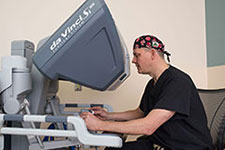What is primary hyperparathyroidism?
Primary hyperparathyroidism is a metabolic disorder in which one or more of the parathyroid glands produces too much parathyroid hormone. This can result in the loss of bone tissue. This condition is more common in women than in men.
A job of the parathyroid hormone is to keep blood calcium levels from going too low. This is done by releasing calcium from bones. The hormone also conserves calcium that would be excreted by the kidneys, and increases how much calcium is absorbed from food. When the hormone overacts, the result is a rise in the blood calcium level. Too much parathyroid hormone causes too much calcium to be released from bone.
When there is a benign tumor in a parathyroid gland, the condition is called a parathyroid adenoma. When more than one parathyroid gland becomes enlarged, the condition is called parathyroid hyperplasia. Both of these conditions are benign (noncancerous).
What causes primary hyperparathyroidism?
In some cases, no cause can be found. Some known causes include benign (noncancerous) tumors on the parathyroid glands, or enlargement of the glands.
What are the symptoms of primary hyperparathyroidism?
The following are the most common symptoms of primary hyperparathyroidism. However, each person may experience symptoms differently. Symptoms of too much calcium in the blood may include:
- Loss of appetite
- Increased thirst
- Frequent urination
- Lethargy and fatigue
- Muscle weakness
- Joint pain
- Constipation
- Kidney pain (due to the presence of kidney stones)
Other serious symptoms may include:
- Nausea
- Vomiting
- Abdominal pain
- Memory loss
- Depression
The symptoms of primary hyperparathyroidism may look like other medical conditions or problems. Always consult your doctor for a diagnosis.
How is primary hyperparathyroidism diagnosed?
The disorder may not have any symptoms or complications. Sometimes this problem is found during a routine blood test as part of a physical exam.
To diagnose primary hyperparathyroidism , you may have a dual X-ray absorptiometry. This test is also called bone densitometry. It is done to determine bone density and to reveal loss of bone tissue. Bone densitometry is also used to continually monitor the disorder.
How is primary hyperparathyroidism treated?
Specific treatment for primary hyperparathyroidism will be determined by your doctor based on:
- Your age, overall health, and medical history
- Extent of the disease
- Your tolerance for specific medications, procedures, or therapies
- Expectations for the course of the disease
- Your opinion or preference
Surgery to remove the affected gland may be needed. Treatment may include continual monitoring with bone densitometry to reveal loss of bone tissue, and to determine if surgery may be needed.
Key points about primary hyperparathyroidism
Primary hyperparathyroidism is a metabolic disorder in which one (or more) of the parathyroid glands produces too much parathyroid hormone. Too much parathyroid hormone causes too much calcium to be released from bone. This can result in the loss of bone tissue.
- It is more common in women than in men.
- Some known causes include benign tumors on the parathyroid glands, or enlargement of the glands.
- Symptoms include loss of appetite, increased thirst, frequent urination, lethargy and fatigue, muscle weakness, joint pain, constipation, and kidney pain
- It is sometimes found during a routine blood test as part of a physical exam.
- Treatment may include monitoring with bone densitometry to reveal loss of bone tissue, and to determine if surgery may be needed.
Next steps
Tips to help you get the most from a visit to your health care provider:
- Before your visit, write down questions you want answered.
- Bring someone with you to help you ask questions and remember what your provider tells you.
- At the visit, write down the names of new medicines, treatments, or tests, and any new instructions your provider gives you.
- If you have a follow-up appointment, write down the date, time, and purpose for that visit.
- Know how you can contact your provider if you have questions.














